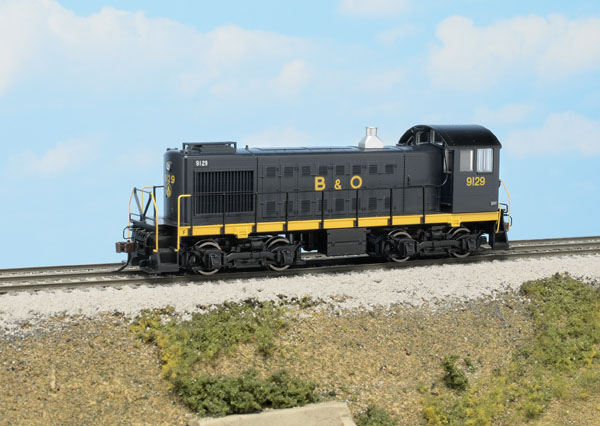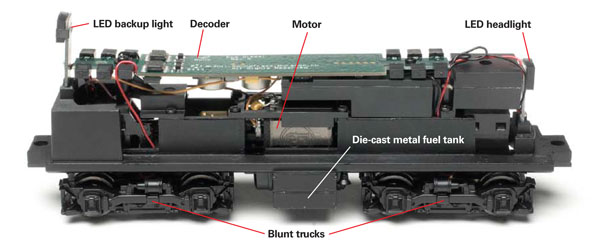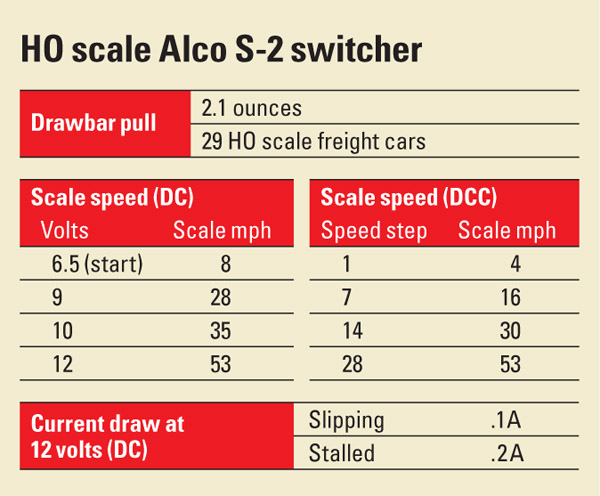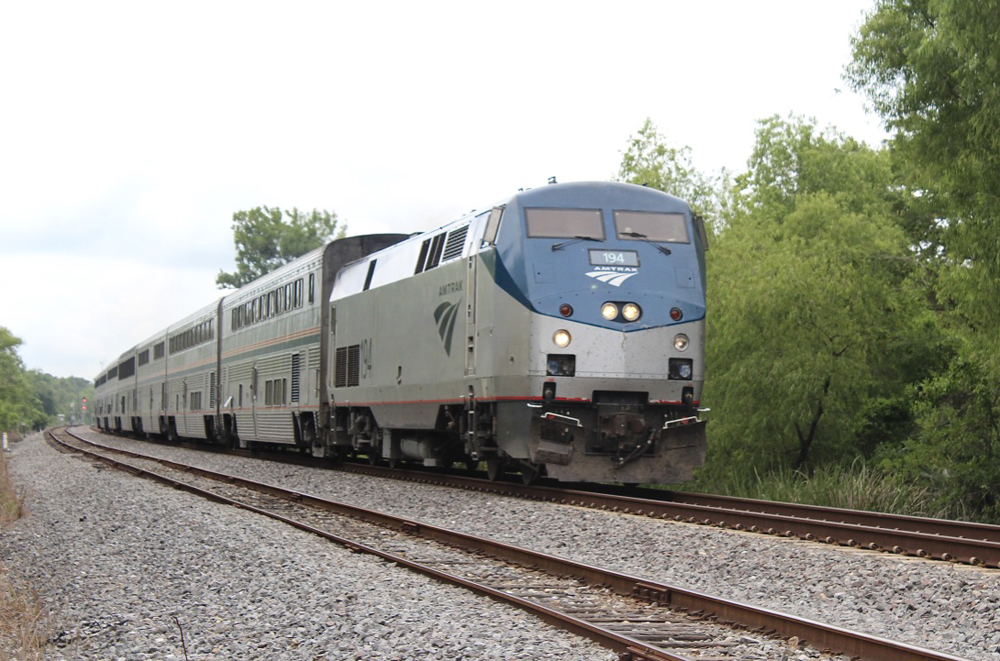The prototype. The 1,000 hp S-2 switcher was Alco’s best selling diesel-electric locomotive ever. Produced from April 1940 to June 1950, Alco sold 1,502 S-2 switchers to railroads across the United States, Canada, and Mexico.
In 1950, the S-4 switcher replaced the S-2 in Alco’s product line. The locomotives were virtually identical. The main spotting difference between the locomotives is that the S-2 rode on Blunt trucks and the S-4 rode on AAR type A trucks.
Early production S-2s had radiator shutter assemblies that were countersunk in the sides of the hood and a circular radiator fan housing on top. Later S-2s had protruding shutter assemblies and square radiator fan housings. For most of their production, the shutters were positioned vertically. S-2s built in 1943 and 1944 had horizontal shutters. Some of the later S-2s had cabs and hoods with welded rather than riveted seams.
Alco switchers ran on Class 1 railroads as well as short lines and in industrial service. Most Class I railroads retired their S-2s in the 1970s. A few examples still operate in tourist service.
Our review sample is decorated as Baltimore & Ohio no. 9129, which was part of a group of S-2s delivered in 1949 and 1950. The details on the model are well-defined and match photos of the prototype, including the riveted seams on the cab and hood, vertical radiator shutters, and a square radiator fan housing on top of the hood.
All the handrails are separate parts made of flexible acetal plastic to resist breaking. The uncoupling levers are
separate wire parts.
The prototype B&O no. 9129 had a bell and grab irons mounted on the front of the hood. The engineer’s side of the cab had an all-weather window. These roadname-specific details aren’t included on the Bachmann S-2. These could be added by the modeler as part of a superdetailing project using parts from firms like Cannon & Co. and Detail Associates.
The paint scheme and lettering placement on the model match prototype photos of no. 9129 as the switcher
appeared in the 1960s and 1970s. The black paint has a smooth satin finish. The sill and pilot step handrails are correctly painted yellow.
The printing is straight and opaque. There are Alco builder’s plates printed in their prototypical locations on both sides of the cab.
The motor and brass flywheels sit on the frame. Truck-mounted gearboxes transfer power to all four axles.
The DCC decoder is mounted on top of the motor and flywheel assembly. The downward-facing speaker is attached to the frame.
I ran the model through the yard ladder on our club layout. The S-2 didn’t stall, and the sound and headlight
remained constant as the locomotive ran through the turnouts.
Sound effects. The sound quality of the SoundTraxx SoundValue decoder is just as good as the firm’s fully featured Tsunami decoder. The main difference between the decoders is that the SoundValue version doesn’t have as many programming options, such as the equalizer or reverb effects.
On a DC layout, the sounds are automatic and limited mainly to the engine rpm. These effects sound like the recordings of Alco 539 engines I’ve heard.
There are more sound options when running the S-2 with a DCC system. I set the engine rpm for manual notching. That way, I could use function keys to increase or decrease the rpm independent of the locomotive speed.
Though the SoundValue decoder doesn’t support as many functions as a full Tsunami, the important ones are there. I could ring the bell and blow a long or short horn blast, which is useful for prototypical horn signals. Function 8 mutes all the sounds.
The decoder also features functions for dimming the headlights as well as turning them on or off.
This well-detailed Bachmann model does a great job capturing both the sights and sounds of an S-2 yard goat.
Manufacturer
Bachmann Industries, Inc.
1400 E. Erie Ave.
Philadelphia, PA 19124
www.bachmanntrains.com
Era: 1940 to present day
Road names: DCC sound: Atchison, Topeka & Santa Fe; Baltimore & Ohio; Pennsylvania; Union Pacific; and United States Army. DC no sound version: Chicago, Burlington & Quincy; CP Rail; Nickel Plate Road; Southern Ry.; and Western Pacific
Features
- All-wheel drive and electrical pickup
- Blackened metal wheels in gauge
- E-Z Mate Mark II knuckle couplers at correct height
- Five-pole skew-wound motor with dual brass flywheels
- Light-emitting diode (LED) headlights
- RP-25 contour metal wheels in gauge
- SoundTraxx SoundValue DCC sound decoder (DCC sound version only)
- Weight: 8.4 ounces


















The motor is a 3 pole motor not a 5 pole as the review states. Had a motor or 2 fail in these and took one apart to fix it to verify the 3 poles,but when the magnets that are glued in the housing drop and hit the spinning armature the motor is junk. These motors are garbage.They are poorly built and have many failures also with the bushings. Junk and no replacement available that will fit except from Bachmann .The same garbage motor. Dont waste your time with these.They look good ,but noting else is good about them except the 3 sounds they have. That is it.Waste of money!
I have 2 of these .They look great in their U P paint. Not so happy when the wheels fell off the axles when running a few hours and the motor growled so loud that it would drown out the sound. So I turned the sound up and the speaker cracked and totally blew out that shorted out the sound decoder and fried it . They replaced it with another just as bad. The sound only has a horn and a bell with incomplete prime mover sounds missing the start up and shut down sequences along with not only the EQ’s ,but brakes fans ,air pumps,pop valves compressors and everything else.These are junk period. They look good ,but even after a little handling the printing comes off the paint in your hand because they never top coat clear seal them. Piece of worthless junk and a great money maker for Bachmann that is it. Shame on them!
Great model and I now have 3 of them. One thing I would like to ask Dana is how do you set the decoder for manual notching I have looked at the Bachmann website and have not been able to find anything.
Rob McLear
Kingaroy Australia.
Dana
I have 3 of these so far, stripped and ready to be painted in the ATSF early switcher scheme of black with silver stripes. However I have no idea of how to initiate manual notching of the engine sound as you describe, can you advise how you went about this. The models are great and you can't beat them for value. The video is one of the better ones that I have heard for the sound quality as well.
Great review!
Will you be doing a review on the new Bachmann F-7A & B
with sound in the near future?
I grew up with the CB&Q version of this running 25 feet from the house, switching in Council Bluffs, Iowa, and the sound is great! Used to leave pennies on the tracks so they would be flattened by the passing trains three or four times a day. Memories were great of those times and this brings 'em back full force! Looking foreward to seeing the paint on the CB&Q version.
Dana, The Fuel Tank with detail described in your article is actually the battery box. Alco S-type switchers have their fuel tanks under the cab and are not externally visible.
R. Dingman, President, New York & Lake Erie Railroad/Oil Creek and Titusville Lines.
Note: Several Alco S-type switchers still perform freight duties every day on shortlines.
Dana, Alco switchers purchased new by B&O had the bell mounted under the frame. A number of these switchers were transferred to B&O by C&O, which ordered their bells mounted on the nose. I had personal experience with at least one from this series, the B&O 9120; these had been C&O motors.
Someone here commented on the shade of blue on this model…it looks about right to my memory. Remember, this engine came from C&O, and the blue shade did as well.
Thanks for the info and demonstration. I've been wanting to know how these models were. Outstanding Video as usual.
I bought one for my small shelf layout. I feel there are sufficient sounds for the value but I do miss the coupler clank especially when switching. Otherwise no regrets.
I thought the B&O engines were dark Blue. At least all the one I've seen are dark Blue. .
??? Frank from Middleboro Mass.
As a steam era S P fan, I'd like to see it offered in the Southern Pacific "Tiger Stripe" paint scheme.
Bought the Bachmann ATSF S4 version with sound for £76 in the UK. How come it costs so much more in the USA.
I have one of these and it is a pretty good engine.
I now want o get the United States Army version.
Just bought a Pennsy unit that I plan to repaint in the GB&W red and gray livery. A great value at a great price. Bachmann is really putting out some quality models with DCC and sound.
could not hear the bachmann soundvalue alco s-2 growls as the magnazine states
I have one on order and I hope it runs as good as the 2 FA-2s that are on my layout. Very good units for the price.
Southern Ry in DCC and sound please.
looking for this in Erie or maybe even AC&Y!!!!
Saw one at the hobby shop They had it on the test track. It looked great and also sounded great. When run alone all was good. When coupled to 5 cars with metal wheels the din from the wheels drowned out the engine sounds. They even had the volume up. At a scale 500' or so away it sounded as if I was on the ground right next to it. I'm not so sure that I will buy any sound equipped engines in the future.
It would be nice if Bachmann offer the CP as sound version.
looks great–wish they had the sound version in southern
It would be nice if they did CP or CN in DCC and sound.
I have a couple of their sound value locos and everything runs and sounds great and the price point is right on.
Too bad it is not in Canadian Nationally livery.